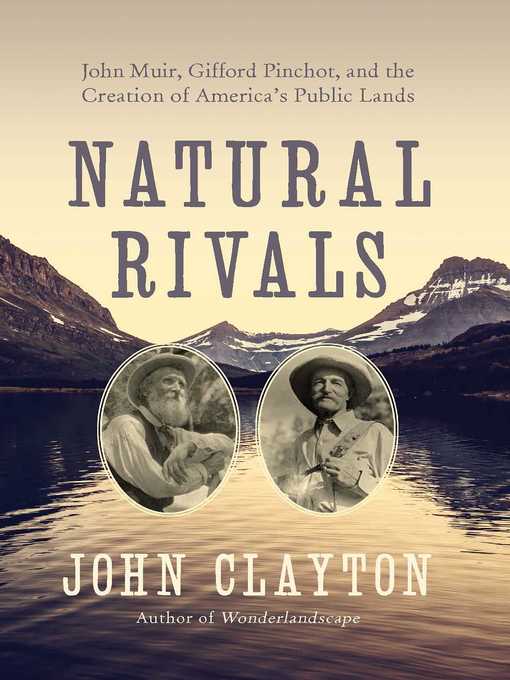
Natural Rivals
کتاب های مرتبط
- اطلاعات
- نقد و بررسی
- دیدگاه کاربران
نقد و بررسی

June 1, 2019
America's battle over conservation vs. preservation. Clayton (Wonderlandscape: Yellowstone National Park and the Evolution of an American Cultural Icon, 2017, etc.) divides his timely book into two parts: the relationship between friends and rivals John Muir (1838-1914) and Gifford Pinchot (1865-1946) and the dense underbrush of events, debates, bills, and laws regarding how America would protect public lands "that demonstrate our society's relationship with nature." Muir, co-founder of the Sierra Club, was a prolific author, scientist, and political activist who helped protect Yosemite. He was raised in an evangelical farming family but slowly turned away from it, passionately appreciating God through the works of nature. Pinchot's family was wealthy. He dreamed of becoming America's first forester and served as President Theodore Roosevelt's chief adviser on environmental issues. Muir too was friends with the nature-loving president. Pinchot went on to found the U.S. Forest Service in 1905. Clayton looks at the issue of public lands through the lens of these two, seemingly like-minded men: prophet vs. statesman, a romantic vs. a practical man, and Muir's moral authority vs. Pinchot's tactical genius. As the author shows, they were collaborative rivals, each offering "alternative paths to articulating a constructive societal relationship to nature." He uses the battle over damming Yosemite's Hetch Hetchy Valley to provide water to San Francisco as a key factor in understanding the Muir-Pinchot rivalry. Muir fought hard against it; Pinchot acquiesced. Muir lost. Ultimately, "their friendship was drowned under a reservoir." The book is populated with a number of fascinating figures: Frederick Law Olmsted; co-editor of The Century magazine, Robert Underwood Johnson; and Aldo Leopold, who argued for balancing the use of public land with sustainable logging and water supplies. Today, Clayton writes, we need a "visionary management framework," not "culture wars." A substantial contribution to understanding our environmental past.
COPYRIGHT(2019) Kirkus Reviews, ALL RIGHTS RESERVED.

June 24, 2019
Naturalist John Muir and U.S. Forest Service founder Gifford Pinchot, usually portrayed as rigid symbols of warring preservation vs. conservation approaches to public-land management, in fact had a nuanced rivalry with hopeful ramifications for modern environmental issues, argues journalist Clayton (Wonderlandscape) in this hybrid biography-history. The first of the book’s two parts begins with sketches of Muir, a writer and scientist best known for his role in the creation of Yosemite National Park and the Sierra Club, and Pinchot, who had a privileged upbringing and studied forestry, embraced a pragmatic attitude toward nature, and influenced President Theodore Roosevelt’s environmentalism. Clayton details Muir and Pinchot’s differing views on the controversial Hetch Hetchy dam in Yosemite, which, in a defeat for Muir, was built. In the book’s second half, Clayton widens his scope, looking at how public lands became a uniquely “American hallmark.” He posits that Muir and Pinchot’s differing approaches, far from causing an irreparable rift, balanced each other out and nurtured the lasting “belief that an American landscape could be productively managed, through democratic processes, for the benefit of all.” Readers will share Clayton’s hope that a similar “marriage of morality and capability” can help solve today’s most pressing issues. Agent: Laura Wood, Fine Print Literary.

July 1, 2019
Sometimes referred to as the father of the national parks, John Muir (1838-1914) remains a legend among naturalists for his enduring influence on safeguarding unblemished wilderness treasures like Yosemite and Yellowstone for future generations. By contrast, forestry expert Gifford Pinchot, born 30 years after Muir and now nearly forgotten, developed a more open philosophy regarding land use, pushing for extensive logging and mining while still avoiding wholesale natural destruction. Despite their differing environmental philosophies, as Montanan Clayton (Wonderlandscape, 2017) makes clear from the outset of this crisply written double biography, the two men were more often friends than adversaries. Clayton paints vivid portraits of each, with Muir as the bedraggled backwoods explorer whose storytelling could charm the rich and powerful into supporting his causes, while practically minded New Yorker Pinchot peddled science and profitability to win political backing for his schemes. What makes their stories especially compelling is their preservation versus conservation debate, which still rages as environmentalists struggle to protect America's natural resources from predatory special interests.(Reprinted with permission of Booklist, copyright 2019, American Library Association.)

























دیدگاه کاربران